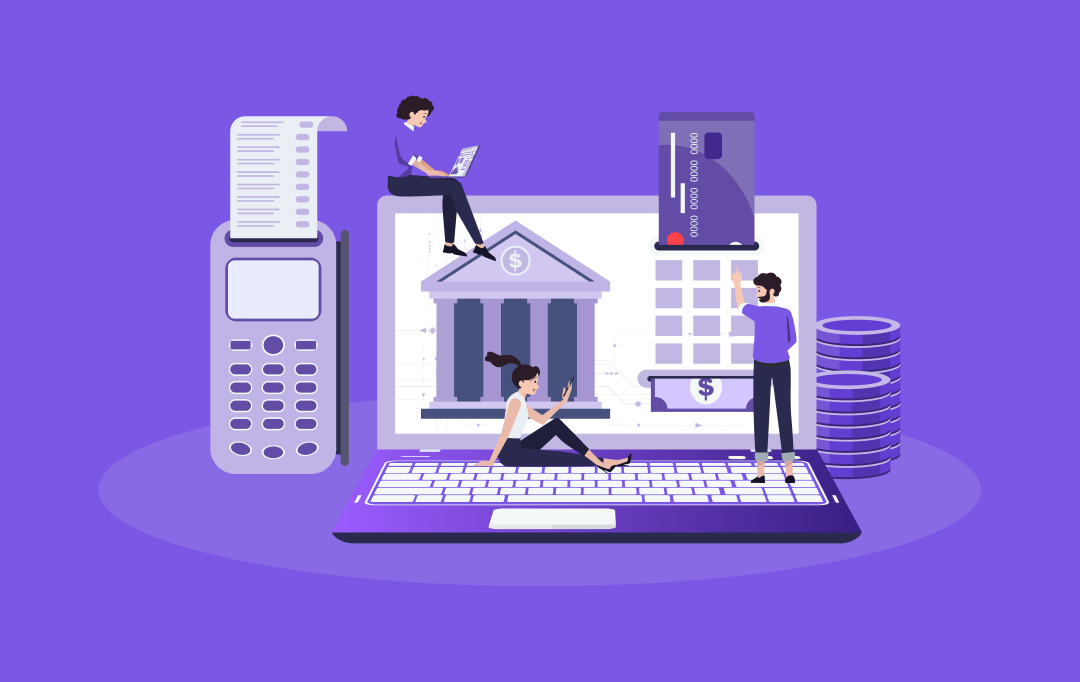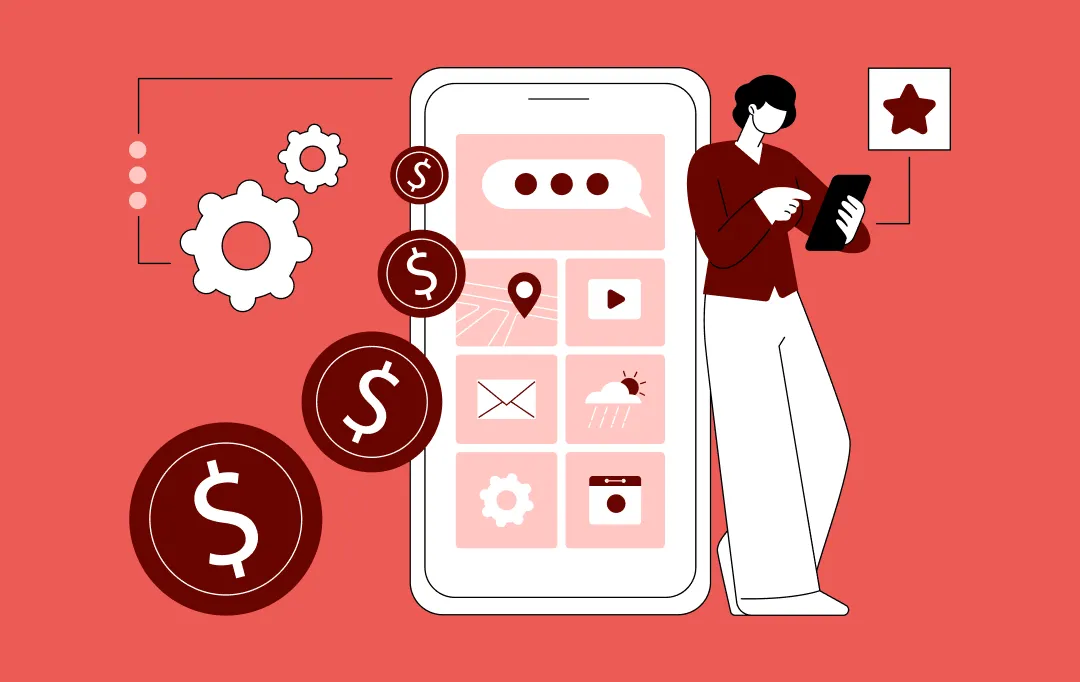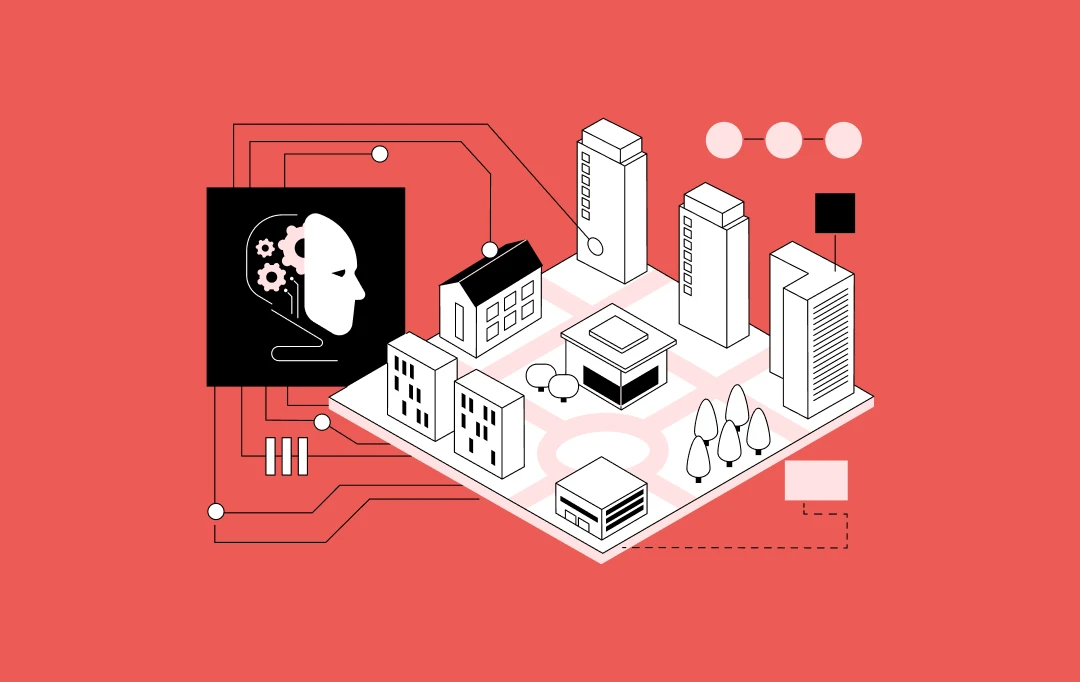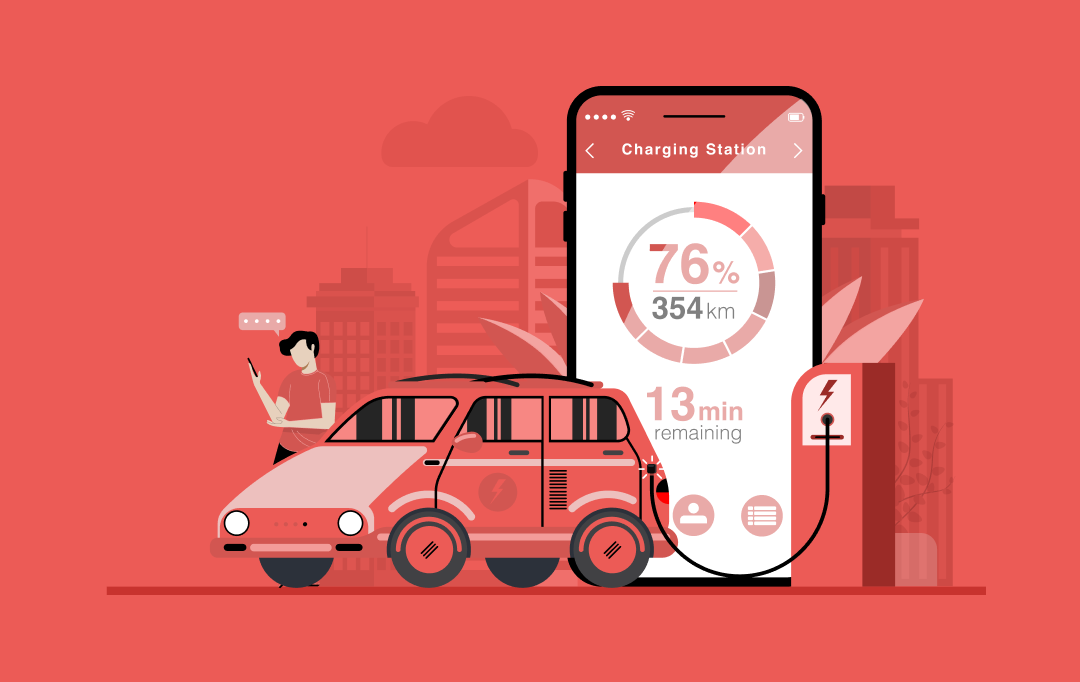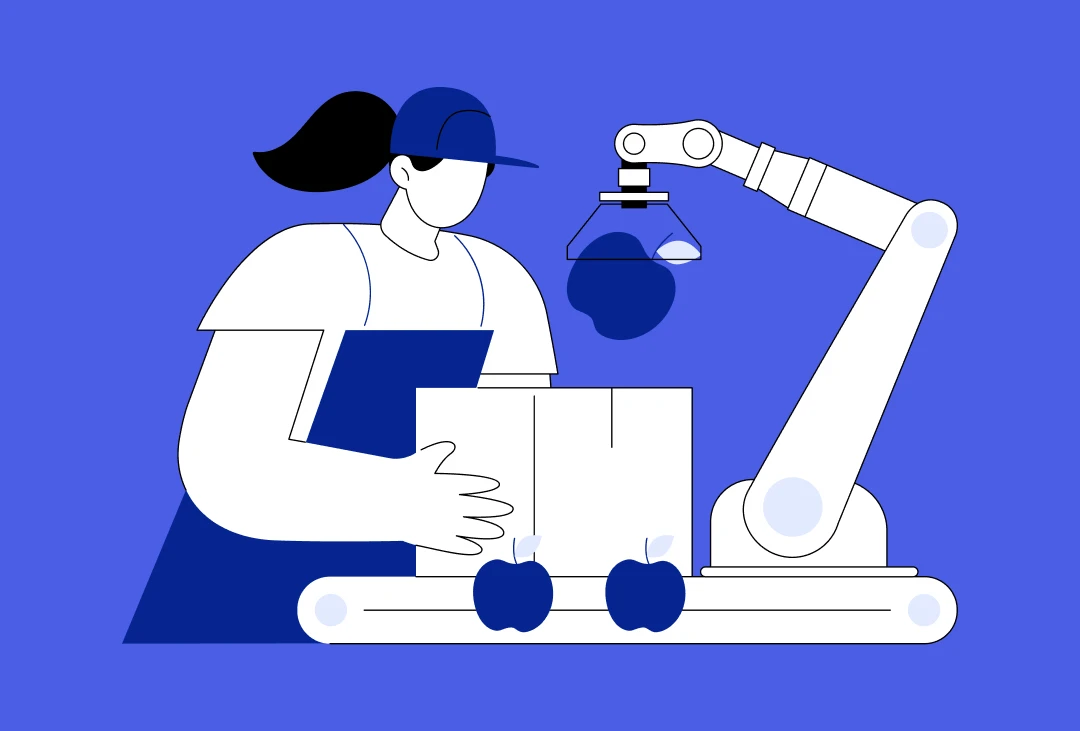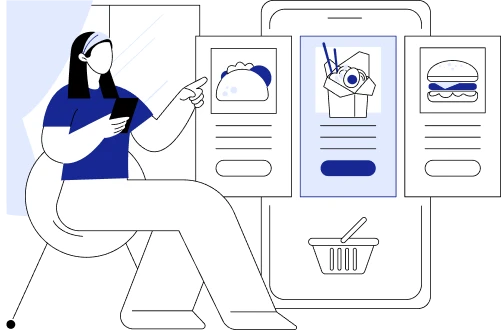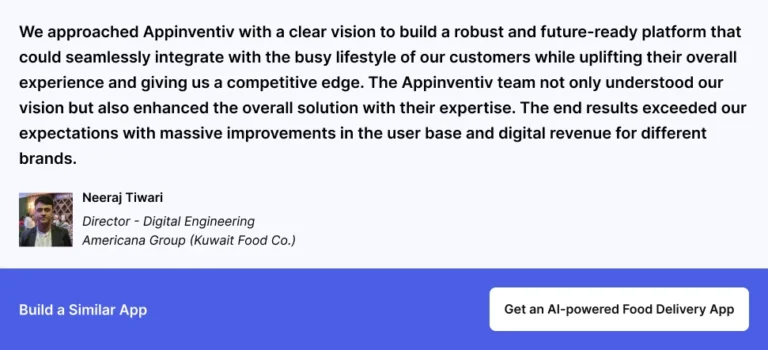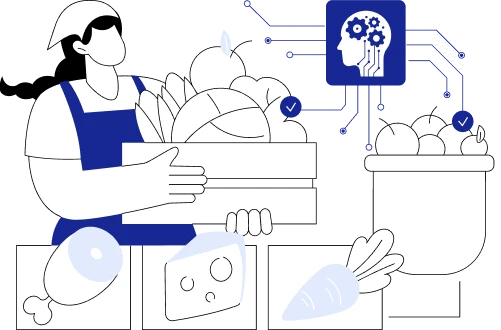- The Role of AI in Food Delivery App Development: Revolutionizing the Global Food Market
- Game-Changing Use Cases and Examples of AI-Powered Food Delivery Applications
- 1. AI-Powered Quality Control and Food Inspection
- 2. AI-Driven Demand Forecasting
- 3. Personalized Food Recommendations
- 4. Smart Food Processing and Automation
- 5. AI for Food Safety and Compliance Monitoring
- 6. Generative AI for Recipe and Product Innovation
- 7. AI Chatbots and Virtual Ordering Assistants
- 8. Supply Chain Optimization
- 9. Predictive Inventory Management
- 10. Dynamic Pricing and Surge Management
- 11. Fraud Detection and Security
- How Appinventiv Helped Americana Group Redefine Its Presence in the Food Industry
- Pizza Hut
- KFC
- Benefits of AI in Food Delivery Software Apps
- 1. Enhanced Operational Efficiency
- 2. Cost Optimization
- 3. Superior Customer Experience
- 4. Data-Driven Decision Making
- 5. Scalability and Flexibility
- 6. Enhanced Food Safety and Compliance
- 7. Competitive Advantage
- 8. Waste Reduction and Sustainability
- Steps to Integrate AI into Your Food Operations
- Identify Key Areas for AI Implementation
- Gather and Analyze Data
- Select the Right AI Tools and Technologies
- Develop and Train AI Models
- Test and Optimize AI Solutions
- Monitor and Scale AI Applications
- Challenges of AI in the Food Industry and How Businesses Can Solve Them
- On-Demand AI in Food Delivery App Development Cost
- How Is AI Transforming The Future of Online Food Ordering?
- 1. Generative AI for Content and Menu Innovation
- 2. Autonomous Delivery Systems
- 3. Voice-First Ordering Experiences
- 4. AR/VR Integration
- 5. Predictive Health and Nutrition AI
- 6. Blockchain for Transparency
- 7. Climate-Aware AI
- Unlock Opportunities in Your Food Business with Appinventiv’s Intelligent AI Services
- FAQs
Key Takeaways
- Global online food delivery is projected to cross $1.89 trillion by 2029. This growth is specifically led by artificial intelligence.
- AI in food delivery mobile applications drives efficiency, saves cost and even enhance customer loyalty.
- For food delivery, AI transforms every stage such as demand forecasting, dynamic pricing, hyper-personalized recommendations and more.
- Smarter cost control. Early compliance planning cuts remediation costs by up to 40% while improving audit speed.
- The cost of integrating artificial intelligence in food apps ranges between $30,000 and $600,000 or more.
Rising costs. Labor shortages. Unpredictable demand. Fierce competition.
Sound familiar? If you’re running a QSR (Quick Service Restaurant) chain, managing cloud kitchens, or leading a food delivery platform, you know these aren’t just challenges; they’re your daily reality.
So here’s what really matters: How are you overcoming these barriers and staying ahead? The answer isn’t just grabbing whatever technology looks shiny. It’s about strategically implementing artificial intelligence across your food delivery operations.
We’re talking systems and applications that predict demand spikes before they smack you, optimize delivery routes in real time, personalize every customer touchpoint without manual work, and automate quality checks at massive scale.
This isn’t futuristic fantasy anymore. It is AI in action and your competitors are already rushing to AI in food delivery app development.
For CEOs and CTOs in the food and beverage sector, AI powered app development has moved beyond the “nice-to-have” category. It’s about embedding intelligence into the very architecture of your operation to enhance efficiency, eliminate waste, and cultivate a legion of delighted customers. These are all the powerful drivers of your bottom line.
But where do you actually start? How do you move from theory to a fully developed and deployed solution? Not sure what a proven AI development process looks like that can help you reap real results? Well, this blog is your go-to guide. It will take you through everything, from practical AI features you can implement to agile development process, tech stack, estimated costs, and actual ROI.
Reimagine your food delivery value chain with AI-powered apps engineered by Appinventiv’s experts.
The Role of AI in Food Delivery App Development: Revolutionizing the Global Food Market
AI in the food and beverage sector is doing more than just automating processes. It’s actively reshaping how brands build, deploy, and scale digital ecosystems. Custom AI apps in the food industry offer innovative solutions to age-old challenges in food production, distribution, and customer interaction.
In short, AI in food delivery apps has evolved from a competitive advantage to absolute essential. What does this mean for you?
According to McKinsey research, food and beverage companies with $10 billion in revenue could unlock $810 million to $1.6 billion in value through digital and AI transformations across their entire value chain. Much of this value comes from embedding AI into app infrastructure, from intelligent order routing and automated procurement modules to AI-powered customer relationship engines.
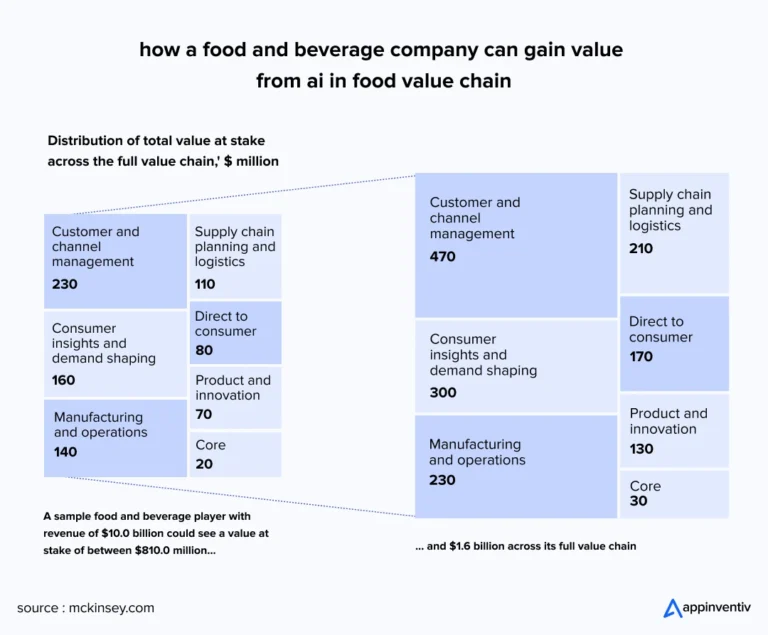
When it comes to customer engagement, BCG’s research reveals something fascinating: Generative AI in food industry is revolutionizing how leading restaurants communicate with customers, helping them eliminate bottlenecks and deliver highly personalized recommendations and offers. This technology has been proven to drive repeat visits and boost revenue by 6% to 10%.
Here’s where it gets really interesting, though. The AI in the food & beverages market was valued at $8.45 billion in 2023 and is anticipated to reach $84.75 billion by 2030, growing at a staggering CAGR of 39.1%. That’s 10x growth in seven years.
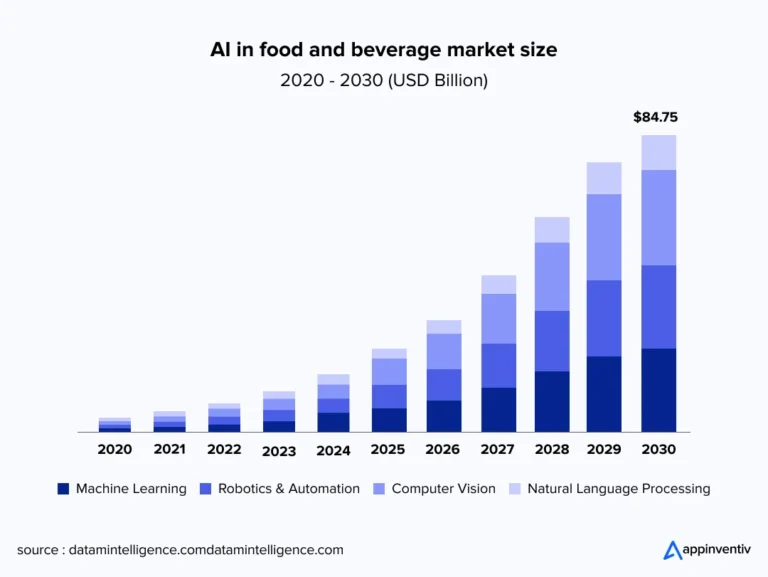
These numbers reflect the wider and broader use of AI in food and beverage industry, from automation and predictive analytics to customer relationships and supply chain management.
So, are you still observing the AI wave from the sidelines? The food industry’s next revolution has already begun, and those investing in AI-driven app development today will define tomorrow’s market leaders.
Game-Changing Use Cases and Examples of AI-Powered Food Delivery Applications
AI-enabled food delivery apps aren’t just about placing orders anymore. They’re creating intelligent ecosystems that predict, personalize, and optimize every interaction. Let us look into the major use cases of AI-powered food delivery app development below:
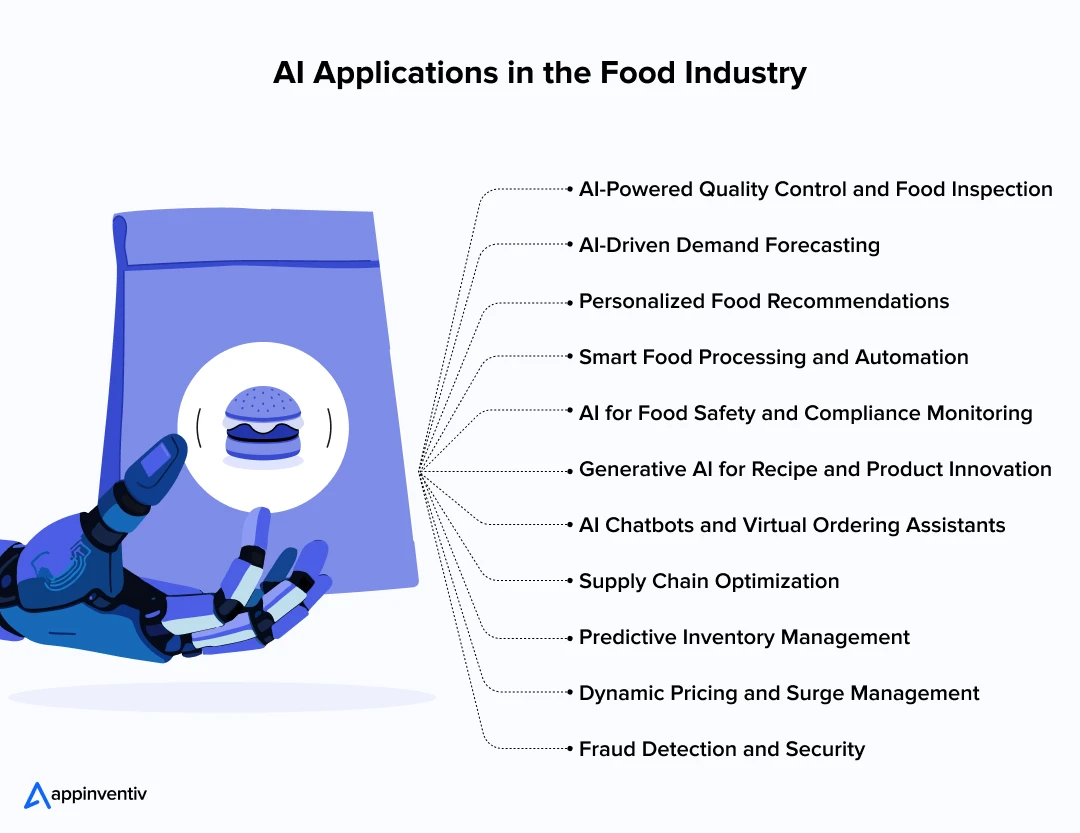
1. AI-Powered Quality Control and Food Inspection
Ensuring food safety and consistency at scale is a constant challenge. Traditional human inspection can’t always catch every flaw, but AI can. AI ensures every meal meets your brand’s quality standards.
AI-powered food apps with vision control can analyze thousands of products per minute to detect imperfections, contamination, or irregular packaging. These AI models are built using computer vision and deep learning that can scan even microscopic differences in color, shape, or size.
AI Tech Stack in Action
These systems are built with computer vision libraries like OpenCV and deep learning frameworks such as TensorFlow or PyTorch. They can be trained to identify dozens of unique defects simultaneously, operating at speeds no human team could match.
Real World Example: DoorDash uses AI-driven computer vision to detect packaging damage and verify order accuracy before delivery. The system flags anomalies like missing items or spilled meals using image analysis, improving quality assurance and reducing customer support tickets.
Your Next Move
- You can start by auditing your quality control process to define the development scope for a computer vision module.
- Partner with an expert AI development team like Appinventiv to train models on your specific products and defect types.
- Start with pilot line testing accuracy against human inspectors. Roll out across facilities once models achieve 95%+ accuracy.
2. AI-Driven Demand Forecasting
Predicting food demand accurately means the difference between profit and waste. AI predicts what customers will order before they do. AI-powered demand forecasting apps for food delivery analyze historical sales data, weather forecasts, local events, and online sentiment to forecast what customers will order next.
By using these insights, restaurants and food chains can better plan procurement, production, and delivery. How does AI make this possible? AI in food delivery apps uses machine learning algorithms to analyze multiple data streams simultaneously.
AI Tech Stack in Action
Python with TensorFlow or PyTorch handles predictive modeling, while Apache Kafka manages real-time data streaming. PostgreSQL stores your time-series data efficiently.
Real World Example: Uber Eats uses AI-powered predictive analytics to forecast demand surges across cities. Its models factor in weather, traffic, time of day, and local events to allocate delivery partners and balance kitchen load, improving on-time delivery rates and reducing idle fleet costs. The result? Reduced food waste, optimized production schedules, and improved product availability.
Your Next Move
- Collect order and sales data to train predictive models.
- Hire AI developers to build forecasting models.
- Begin with your top 20 menu items, measure accuracy, then expand.
3. Personalized Food Recommendations
AI makes every customer interaction personal. AI in food delivery apps transforms everything, from how users explore food choices to place orders and even track deliveries. What’s more? AI-powered recommendation engines study past orders, spending behavior, and dietary choices to predict what users want next.
By understanding patterns and preferences, food delivery apps can help serve tailored dishes that increase engagement and retention.
AI Tech Stack in Action
Python with scikit-learn for collaborative filtering, Apache Spark processing large-scale behavioral data, MongoDB storing detailed user profiles, Redis delivering split-second recommendations without lag.
Real World Example: McDonald’s uses AI-based decision technology through its Dynamic Yield platform to personalize drive-thru and digital menu boards. Depending on the weather, time of day, trending orders, and customer profiles, McDonald’s adjusts menu displays in real-time to suggest items most likely to appeal to each customer. This AI application in food service has led to increased average order values and improved customer retention.
Your Next Move
- Start collecting customer data like order history, preferences, and dietary restrictions.
- Partner with AI developers to integrate behavioral analytics into your delivery platform.
- Launch pilot with 10% of users, measure increased order values and repeat rates against the control group.
4. Smart Food Processing and Automation
Manual food processing creates bottlenecks, inconsistencies, and safety risks that kill profitability. AI automation in food delivery apps eliminates these inefficiencies related to food production and packaging. From robotic sorting and slicing to automated quality checks, AI in food applications ensures precision, speed, and consistency in every process.
AI Tech Stack in Action
Industrial robots are controlled by reinforcement learning algorithms. Computer vision systems built with TensorFlow identify defects instantly. IoT sensors feed real-time data through Azure IoT Hub. Meanwhile, predictive models developed with Scikit-learn forecast equipment maintenance needs.
Real World Example: Domino’s uses AI-driven kitchen automation for dough preparation and ingredient dispensing. The system ensures consistent quality across stores while cutting prep time significantly.
Your Next Move
- Assess current processing operations for automation opportunities immediately.
- Identify repetitive tasks causing bottlenecks, such as cutting, sorting, and packaging.
- Start with one processing line as proof of concept and scale successful implementations across facilities once ROI proves out.
5. AI for Food Safety and Compliance Monitoring
Food safety violations can destroy a brand overnight. One small incident can cost millions or sometimes lifetimes to improve brand image. AI-powered food apps monitor temperature, hygiene, and storage conditions in real time, ensuring compliance with food safety regulations.
AI Tech Stack in Action
IoT temperature sensors streaming data through AWS IoT Core. Machine learning models detecting anomalies using Python and scikit-learn. Blockchain technology ensures immutable traceability records via Hyperledger Fabric. Automated reporting dashboards built with Tableau.
Real World Example: Just Eat Takeaway uses AI and IoT data to monitor kitchen compliance and delivery conditions across partner restaurants. When contamination occurs, the system identifies affected products within seconds instead of days.
Your Next Move
- Audit current food safety protocols to identify gaps where AI monitoring would prevent issues.
- Install IoT sensors at critical control points to monitor kitchen and delivery temperatures
- Partner with a compliance-focused AI development company to implement real-time dashboards for compliance tracking.
6. Generative AI for Recipe and Product Innovation
Generative AI in food delivery apps is changing how new food items are conceptualized and tested. Instead of relying solely on chefs and R&D teams, food companies are using AI to create recipes that meet nutritional targets, flavor profiles, and regional trends.
By analyzing millions of ingredient combinations, these models predict how different ingredients will interact, cutting months off traditional recipe testing cycles and improving product-market fit.
AI Tech Stack in Action
Generative AI systems use ChatGPT-4 for enterprises and similar large language models for ideation, TensorFlow for data modeling, and Python APIs for nutritional and sensory simulations.
Real World Example: NotCo, a Chilean food tech company, uses its AI platform “Giuseppe” to create animal-free versions of popular foods. The AI analyzes thousands of plant ingredients, predicting combinations replicating the taste and texture of dairy and meat products. Giuseppe created NotMilk, a plant-based milk matching dairy milk’s taste, in months instead of the years traditional R&D requires. The product achieved a 70% repeat purchase rate, proving AI-generated recipes can succeed commercially while cutting development costs by 60%.
Your Next Move
- Use public or proprietary ingredient datasets to train your own generative models.
- Collaborate with food app development company to test and validate AI-generated recipes.
- Implement feedback loops from taste tests to refine model accuracy.
7. AI Chatbots and Virtual Ordering Assistants
Customer expectations for instant communication have redefined service in food delivery. AI chatbots in food delivery applications now act as 24/7 digital concierges that instantly answer queries, take orders, resolve complaints, and even recommend meals based on user preferences.
AI Tech Stack in Action
Dialogflow or Rasa frameworks providing NLP capabilities. Python with BERT or GPT models understanding context and intent, WebSocket technology enabling real-time communication and MongoDB storing conversation histories for continuous learning.
Real World Example: Domino’s “Dom” virtual assistant handles orders through voice, text, and social media platforms. Customers order pizza by simply saying “the usual” or describing what they want conversationally. Dom processes natural language, confirms orders, tracks delivery, and handles modifications; all without human intervention.
Your Next Move
- Implement AI chatbots on the highest-traffic customer touchpoints first, like website, mobile app, social media platforms.
- Choose between building custom or using pre-built solutions based on your needs.
- Use reinforcement learning to refine responses based on customer satisfaction metrics.
8. Supply Chain Optimization
Supply chain inefficiencies bleed money on every transaction in terms of overstocking, stockouts, and inefficient routes. AI-powered supply chain optimization track everything, from ingredient sourcing to last-mile delivery, to minimize waste, cut costs, and maintain reliability.
By combining real-time fleet data, predictive analytics, and smart routing, AI enables better route planning and inventory distribution. This leads to reduced delivery times, lower emissions, and optimized kitchen throughput.
AI Tech Stack in Action
Python with forecasting models such as Prophet or ARIMA helps predict demand patterns. Optimization algorithms powered by OR-Tools identify the most efficient delivery routes. Apache Kafka streams real-time supply chain data seamlessly, while cloud platforms like GCP provide the scalable processing power needed to handle it all.
Real World Example: Deliveroo uses AI-driven logistics to optimize order batching and rider dispatching. Its system factors in food prep times, distance, and rider availability. This AI capability ensures timely deliveries while reducing idle time and operational costs.
Your Next Move
- Map entire supply chain and identify inefficiency points such as procurement delays, route inefficiencies, and supplier issues.
- Start with pilot programs in one region, measure cost savings and reliability improvements, then scale nationally.
- Partner with supply chain AI specialists for faster deployment.
9. Predictive Inventory Management
Inventory shortages and overstocking cost serious money; too much creates waste, too little loses sales. AI-powered inventory management systems help food delivery partners maintain the perfect balance, ensuring every ingredient is available, fresh, and efficiently used.
By analyzing sales data, seasonality, and vendor timelines, AI models forecast ingredient demand and automate reordering. This minimizes spoilage while keeping kitchens ready for any surge in demand.
AI Tech Stack in Action
Python with LSTM neural networks analyzing time-series patterns. PostgreSQL stores historical inventory data, Apache Airflow orchestrates automated workflows, and visualization tools like Tableau provide actionable dashboards.
Real World Example: Grubhub uses AI-based predictive analytics to assist partner restaurants in inventory planning. The platform’s demand forecasts help optimize procurement and reduce wastage, improving margins across its partner network.
Your Next Move
- Deploy automated reordering systems integrated with your existing POS and ERP systems.
- Use AI forecasting to automate purchase orders for high-velocity items.
- Measure waste reduction and availability improvements monthly, and adjust algorithms based on results.
10. Dynamic Pricing and Surge Management
Customer demand in food delivery fluctuates by the hour, location, and event. AI dynamic pricing applications for food delivery continuously analyze market signals to adjust delivery fees, menu prices, and discounts. These AI models balance the interests of customers, restaurants, and delivery partners in real time, improving efficiency across the ecosystem.
AI Tech Stack in Action
Python with reinforcement learning frameworks like Ray RLlib optimizes pricing strategies. Redis provides real-time price updates, Apache Kafka streams market condition data, and A/B testing frameworks measure pricing effectiveness.
Real World Example: Uber Eats utilizes sophisticated AI algorithms that dynamically adjust prices based on restaurant capacity, delivery partner availability, customer demand, and competitor pricing. During high-demand periods, strategic surge pricing balances supply and demand while maximizing revenue. The system also offers personalized discounts to price-sensitive customers at optimal times.
Your Next Move
- Develop a dynamic pricing strategy starting with peak/off-peak differentiation immediately.
- Train reinforcement models on past order and fulfillment data.
- Conduct limited A/B pilots before full-scale pricing automation.
11. Fraud Detection and Security
Fraud costs the food delivery industry billions annually. How? Fake orders, stolen accounts, and payment scams; these all turn into lost revenues and spoilage. AI defends against these threats by spotting abnormal patterns in real time, protecting both the business and customers.
Machine learning algorithms monitor every transaction, identifying deviations from legitimate user behavior such as sudden location changes, high refund frequency, or card mismatches and block them before damage occurs.
AI Tech Stack in Action
Python with XGBoost or Random Forest algorithms detecting anomalies. Apache Kafka enables real-time fraud monitoring, Elasticsearch analyzes log patterns, and graph databases like Neo4j map fraud networks.
Real World Example: DoorDash implemented AI-powered fraud detection to analyze millions of transactions daily. The system identifies suspicious patterns, such as multiple failed payment attempts, unusual ordering behavior, and coordinated fake accounts, blocking fraudulent orders before processing. This protection directly improved bottom-line profitability.
Your Next Move
- Train AI fraud detection models using historical transaction data.
- Connect fraud models to your payment gateway for real-time validation.
- Use predictive analytics to adjust thresholds dynamically as patterns evolve.
Also Read: How Autonomous Food Delivery Robots Work: A Deep Dive into AI, Sensors, and Navigation
How Appinventiv Helped Americana Group Redefine Its Presence in the Food Industry
When Americana Group needed to own its digital narrative instead of relying solely on aggregators, it turned to Appinventiv. Across their flagship brands: KFC, Domino’s, and Pizza Hut, we stepped in to build the modern digital platforms necessary to support future AI integration.
We developed a unified ecosystem that supports personalization, predictive analytics, and real-time customer engagement. Each solution was designed to ensure smooth AI adoption down the road, from data structuring to API readiness.
Pizza Hut
We redesigned Pizza Hut’s mobile experience to streamline ordering and make customer journeys more intuitive.
The Result?
- 30% Increase in conversion rates
- 50K+ downloads within months of launch
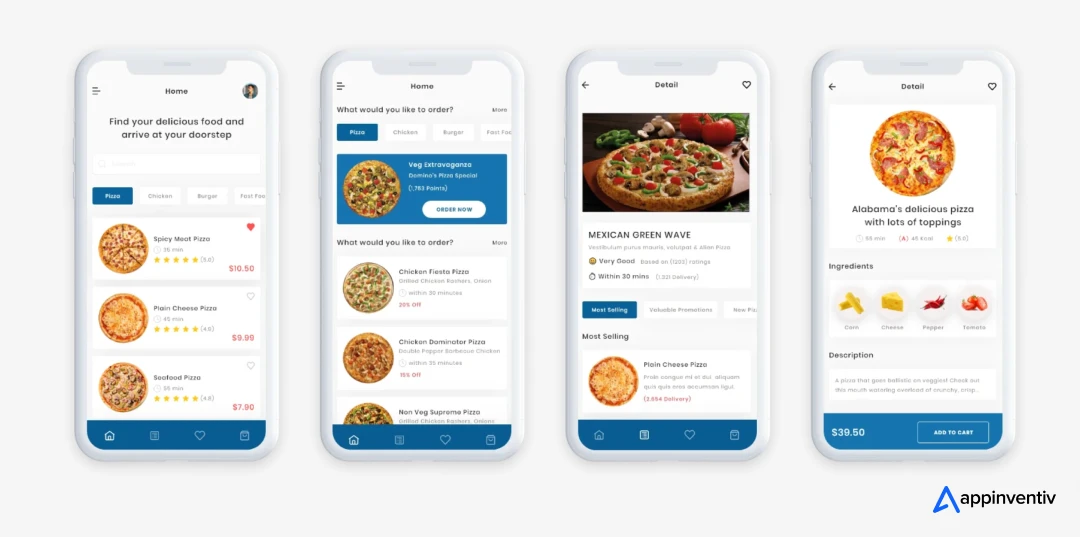
KFC
We supported KFC’s growth across multiple regions by engineering platforms that scale effortlessly and deliver consistent performance worldwide.
The Result?
- 60% Increase in repeat customers
- 22% Higher conversion rates across markets
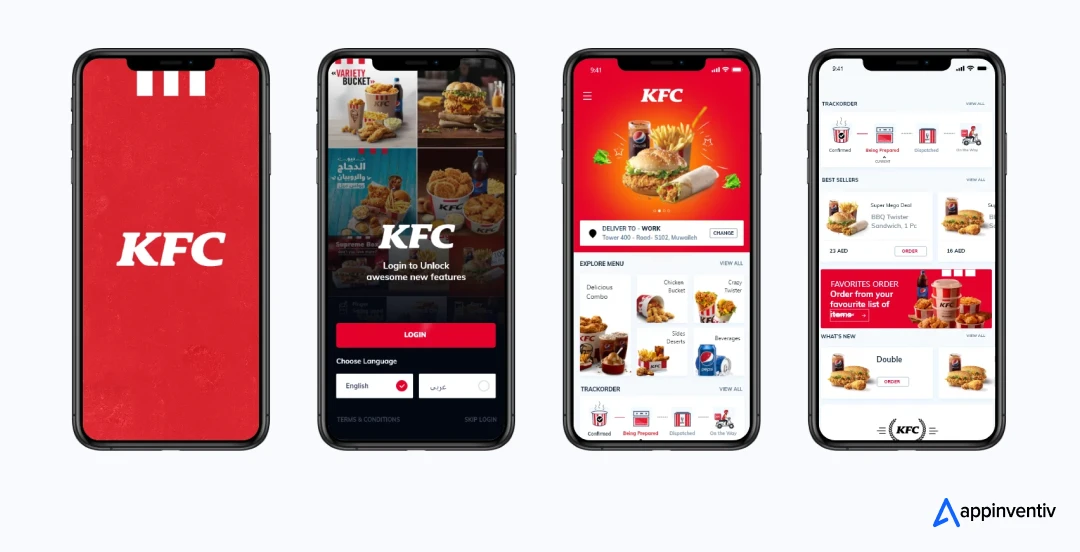
Domino’s
We reimagined Domino’s app experience by simplifying navigation and enhancing UI/UX flows, keeping customers engaged from first tap to final checkout.
The Result?
- 23% Rise in overall conversions
- 4.4 Average rating on app stores
By tailoring systems, localizing features, optimizing performance and future-proofing architecture for AI integration, Americana Group went from dependency on third-party apps to controlling the customer journey and securing stronger brand equity in the digital age.
The transformation allowed the brand to own its data, control the customer journey, and strengthen brand equity, setting a solid foundation for intelligent automation and data-driven decision-making in the years ahead.
If you are still confused regarding the innumerable benefits of AI in food industry, have a look at a few of the most important ones listed below.
Benefits of AI in Food Delivery Software Apps
Implementing AI in the food service industry offers several benefits in terms of enhanced precision, efficiency, and workers’ safety. These advancements lead to cost savings, improved customer experiences, and sustainable practices. Want to know how? Here’s why enterprise leaders are prioritizing AI-powered development:
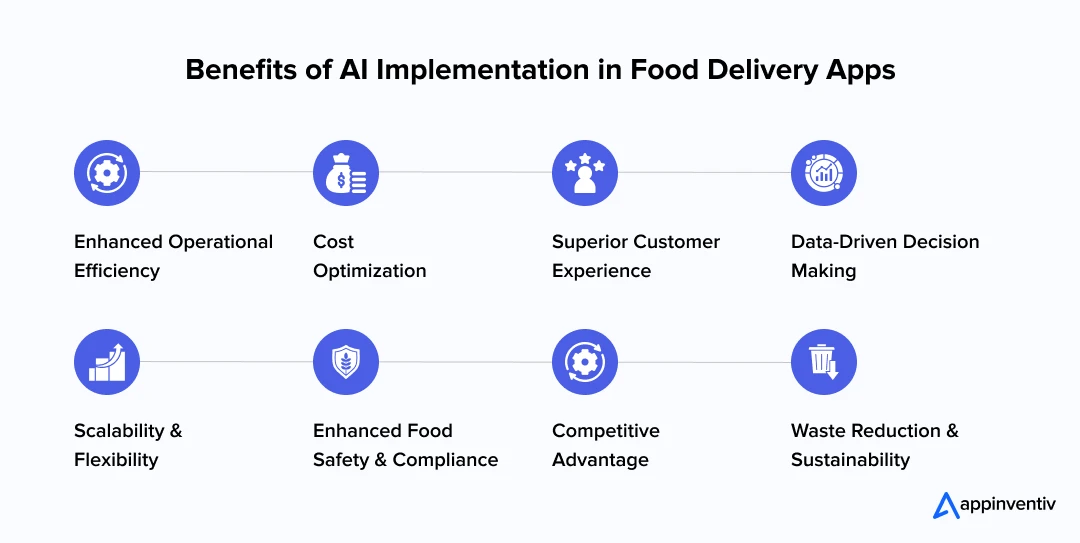
1. Enhanced Operational Efficiency
AI automation handles repetitive tasks from order processing to delivery allocation. This translates to:
- Enhanced reduction in manual errors through automated workflows
- Continuous operations running 24/7 without human intervention
- Faster order processing from minutes down to seconds
- Streamlined kitchen operations with smart order routing
2. Cost Optimization
Investing in AI-driven food delivery app development isn’t just about automation; it is also about cost savings:
- Labor cost reduction through automating customer service, order management, and dispatching
- Reduced fuel consumption translates into saving the company’s budget through optimized delivery routes
- Reduced food wastage with accurate demand forecasting and inventory management
- Predictive maintenance prevents equipment failures, which reduces costly downtime
3. Superior Customer Experience
AI-powered development enables hyper-personalized experiences that drive genuine loyalty:
- AI-driven hyper-personalized recommendations increase order values and decrease cart abandonment rates.
- Instant customer support through AI chatbots and virtual assistants reduces response times from hours to seconds
- Accurate ETAs improve customer trust and overall satisfaction
- Secure payment experiences with built-in fraud detection
4. Data-Driven Decision Making
Applications of AI in food delivery apps collect and analyze data on production, consumer preferences, and equipment performance. Integrating AI in food apps provides actionable insights across:
- Real-time analytics dashboards for performance monitoring
- Customer behavior insights enabling targeted marketing
- Demand patterns informing strategic menu planning
- Competitor analysis through market intelligence
5. Scalability and Flexibility
AI technology in the food industry gets programmed and reprogrammed easily for different jobs, giving you tons of flexibility. AI-powered platforms enable seamless scaling:
- Cloud-based infrastructure (AWS, Azure, or GCP) allows instant scaling during peak demand
- Microservices architecture enables feature updates without system downtime
- Multi-region deployment supporting global expansion
- White-label solutions facilitating franchising opportunities
6. Enhanced Food Safety and Compliance
Food safety regulations are strict worldwide, and manual checks alone can no longer keep pace. AI in food applications ensures regulatory compliance through:
- Automated temperature monitoring throughout the entire supply chain
- Real-time alerts for potential safety breaches
- Traceability systems enabling rapid recall management
- Compliance reporting simplifying regulatory audits
7. Competitive Advantage
Early AI adopters gain substantial market advantages over those who are still thinking or delay in embracing AI for businesses:
- First-mover benefits in AI-driven features
- Higher customer retention through superior experiences
- Operational excellence competitors struggle to match
- Innovation reputation attracts both customers and investors
8. Waste Reduction and Sustainability
AI integration in food applications supports long-term sustainability by minimizing waste and optimizing resources. From smarter inventory management to eco-friendly sourcing, AI ensures responsible operations.
- Demand forecasting reduces overproduction and spoilage
- Smart inventory tracking ensures ingredients are used before expiration
- Energy management systems optimize power consumption
- Data-driven insights promote eco-friendly sourcing and distribution
Also Read: 10 Use Cases and Real Examples of How AI is Used in the Restaurant Industry
Steps to Integrate AI into Your Food Operations
AI in food delivery apps isn’t here to make kitchens colder or take people out of the process. It’s here to make things work better: faster service, fewer errors, smarter decisions, and less waste. When used thoughtfully, it changes how a food business runs from the inside out. Here’s how to successfully weave AI into your food operations:
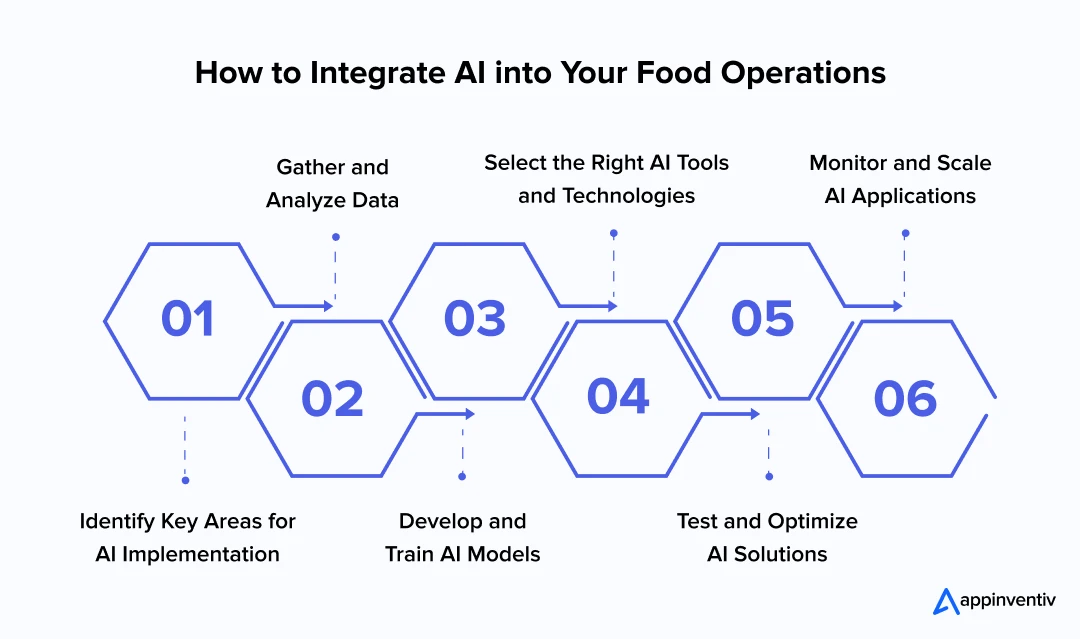
Identify Key Areas for AI Implementation
Start with the Right Problems
Before thinking about tools or algorithms, ask a simple question: Where are we losing time or money? That’s usually where AI can help most. Whether it’s food processing, customer service, inventory management, or production tweaks, figuring out where AI can add value is essential.
AI in food service industry operations, manufacturing and quality control centers offers substantial improvements, so prioritize based on your unique needs and targets.
Don’t try to automate everything on day one. Pick one process that slows you down, and build from there.
Gather and Analyze Data
AI learns from data, but in food operations, that data tells human stories: what customers order, how long meals take, which ingredients run out too early.
Start collecting that information properly. Pull it from sales systems, stock logs, delivery apps, and even feedback forms. Then clean it up; remove duplicates, fill in gaps, make sure it’s consistent.
If your data is messy, your AI will be too. Clean, connected data is what separates good AI from random guesses.
Select the Right AI Tools and Technologies
Every food business is different. A cloud kitchen’s needs are not the same as a packaged-food brand’s. So when you build an AI powered food delivery app, pick the right AI tech stack. Think about what works for your setup and users.
You might need predictive analytics to plan supply runs or image recognition to spot quality issues. Maybe it’s an AI chatbot to handle repeat customer queries. The goal isn’t to have the fanciest tool; it’s to have the right one that quietly fixes the real problems.
Develop and Train AI Models
Once you’ve got your data and chosen the right tools, start small. Partner with a food delivery app development company that understands both AI and the food business. Train your models on real data: your recipes, your timings, your order patterns.
A generic model won’t know that people in the US order differently from people in Dubai. That kind of insight only comes from your data. Custom-built AI learns faster and performs better because it understands your environment from the start.
Test and Optimize AI Solutions
Before rolling anything out fully, test it as if you’re the one using it. Does it make your team’s life easier? Are customers noticing faster service or better recommendations?
Whether it’s AI in food and beverage industry for customer engagement or AI in food manufacturing optimizing production, testing spots the improvement areas and ensures accuracy.
Run small pilots in one branch or process. Watch what happens. Fix what feels off. AI systems get smarter with every iteration but only if you take the time to listen and refine.
Monitor and Scale AI Applications
The AI in food delivery app development process isn’t something you launch and forget. It needs watching, just like your ovens or your delivery vans.
Keep checking if the system is still accurate, useful, and aligned with your goals.
Review the results, measure ROI, and stay open to tweaks. As your business expands, customer habits shift, or new tools emerge; your AI should evolve too.
From kitchen to customer, we make every step smarter, faster, and more profitable.
Challenges of AI in the Food Industry and How Businesses Can Solve Them
While artificial intelligence is driving remarkable transformation in the food industry, the road to implementation is not without barriers. Businesses that are wishing to leverage the maximum advantages of AI in food industry need to proactively address these hurdles:
| Challenge | Description | Solution |
|---|---|---|
| Data Quality and Integration | Fragmented systems and inconsistent data from sensors, suppliers, and manual records can reduce AI effectiveness. | Implement centralized dashboards to unify inventory, production, and customer data for accurate insights. |
| High Implementation Costs | AI-powered robotics, smart processing, and analytics require significant investment. | Use cloud-based and modular AI solutions for gradual scaling and reduced upfront costs. |
| Skills Gap and Workforce Resistance | AI adoption requires technical skills that current staff may lack, causing resistance. | Provide upskilling programs and emphasize AI as a tool that enhances human roles rather than replacing them. |
| Data Security and Privacy | Handling sensitive customer data for personalization and analytics raises privacy concerns. | Apply strong cybersecurity measures and comply with regulations such as GDPR. |
| Transparency and Trust | Complex AI models can be difficult to interpret, creating uncertainty in decision-making. | Adopt explainable AI frameworks to clarify forecasts, recommendations, and quality control results. |
| Regulatory Compliance | Food safety rules vary regionally, and AI systems must meet these standards. | Engage regulators, conduct audits, and build fully-compliant food apps to certify AI systems maintain compliance. |
| Ethical and Consumer Concerns | Hyper-personalization and AI recommendations may feel intrusive to customers. | Maintain transparency, give users control over preferences, and explain AI benefits. |
| Market Acceptance of Generative AI | AI-generated recipes or concepts may not align with consumer tastes or cultural expectations. | Validate concepts through consumer feedback and combine AI outputs with human expertise. |
| Technology Standards and Environmental Impact | Rapid AI development creates integration challenges, and running models can consume high energy. | Adopt interoperable solutions and optimize computing to reduce environmental impact. |
On-Demand AI in Food Delivery App Development Cost
When developing a food delivery app with AI, one of the most critical questions that keeps enterprises awake at night is, “How much does it cost to develop an AI-powered food delivery app?”
Honestly telling, there is no one-size-fits-all approach to quote the exact cost. The answer depends on multiple factors such as the number of features, platform choice, tech stack selection, team location, and project complexity. Here’s a detailed breakdown of on-demand AI food delivery app development cost based on different project complexities:
| App Type | Core Features of Food Delivery App with AI | Development Time | Investment Range |
|---|---|---|---|
| Basic MVP | Core ordering, payment, basic tracking, simple AI recommendations | 3-6 months | $30,000 – $150,000 |
| Mid-Level App | Advanced AI personalization, route optimization, chatbot, multi-platform support | 6-8 months | $150,000 – $300,000 |
| Enterprise Grade App | Full AI suite (ML models, computer vision, predictive analytics, multi-region), custom integrations | 8-12+ months | $300,000 – $600,000+ |
While the cost of food delivery app with AI seems substantial, there are multiple ways you can use to optimize this cost. Want to uncover these cost optimization strategies? Well, here is a table outlining some tried and tested techniques to reduce AI product development costs for food delivery:
| Recommendation | Key Insight |
|---|---|
| Start with MVP | Focus on essential features first and scale gradually based on user feedback. |
| Choose cross-platform | Save 30–40% by using Flutter or React Native instead of building separate native apps. |
| Outsource strategically | Partner with AI experienced teams in cost-effective regions like Asia. |
| Modular architecture | Build scalable, reusable components to reduce future development costs. |
How Is AI Transforming The Future of Online Food Ordering?
The future of AI in food delivery app development isn’t jus
t promising; it’s already unfolding in real-time. Here’s what’s coming next based on current AI trends and emerging technologies:
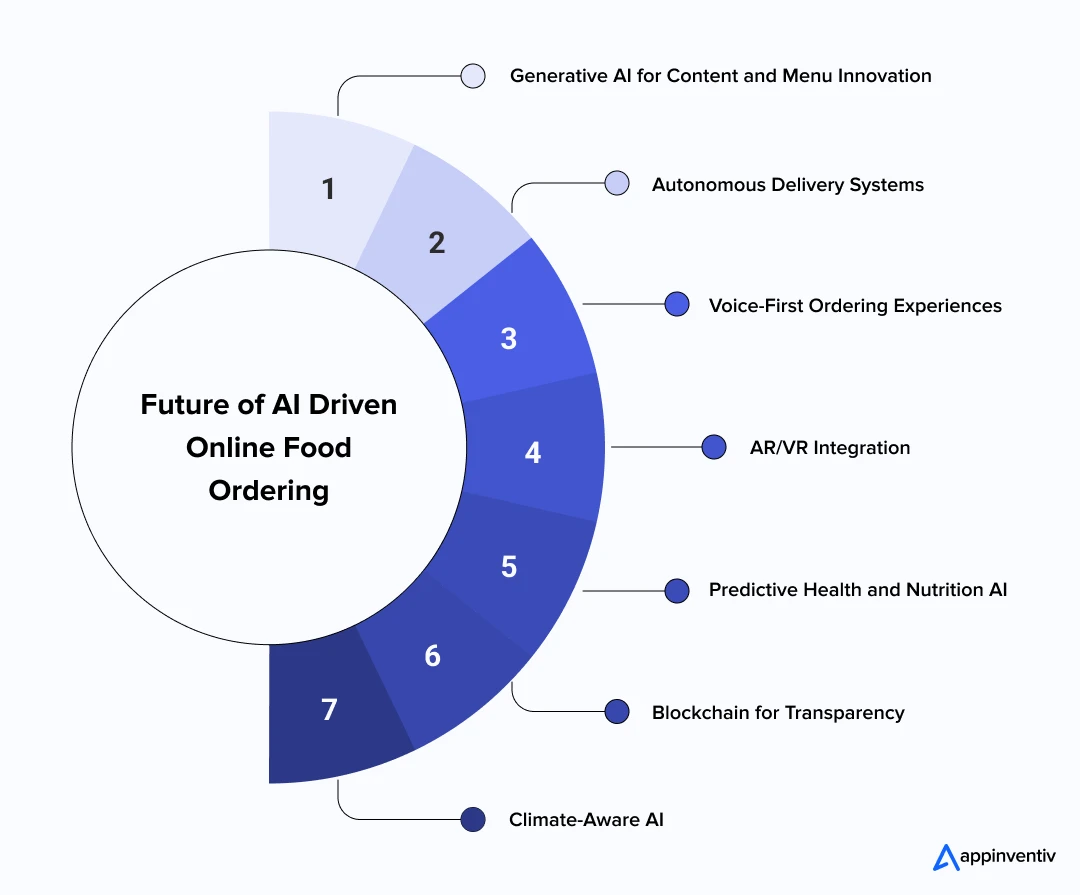
1. Generative AI for Content and Menu Innovation
Generative AI in business will transform menu creation and marketing by providing automated, intelligent, and visually engaging content. Generative AI will revolutionize food delivery through:
- Automated menu descriptions crafted in multiple languages instantly
- Recipe innovation suggesting new dishes based on ingredient availability and customer preferences
- Visual content generation creating appetizing food images for marketing
- Personalized meal planning considering dietary restrictions, budgets, and nutritional goals
2. Autonomous Delivery Systems
Physical food delivery is transforming rapidly with on demand AI food delivery app development. For instance:
- Drone delivery for suburban and rural areas where traditional delivery struggles
- Sidewalk robots navigating urban environments autonomously
- Self-driving vehicles handling bulk deliveries efficiently
- Smart lockers enabling contactless pickup 24/7
3. Voice-First Ordering Experiences
Voice technology is all the rage in the recent years. It is not only dominating eCommerce and entertainment industries but also widening its wings in the food sector. For instance:
- Conversational AI understands complex, multi-item orders naturally
- Voice biometrics for secure, password-free authentication
- Multilingual support breaking language barriers
- Context-aware assistants remembering preferences and dietary restrictions
Also Read: How to Build an AI Voice Agent? Process, Costs & Features
4. AR/VR Integration
AR/VR adoption in food delivery is making waves and creating immersive experiences. This trend will change how customers explore food:
- Virtual restaurant tours before ordering
- 3D food visualization, seeing exact portions and presentations
- AR menu overlays showing nutritional information interactively
- Virtual cooking classes from favorite restaurants
5. Predictive Health and Nutrition AI
AI proactively supports healthier eating by analyzing customer health data and tailoring personalized meal recommendations. AI will proactively manage customer health:
- Wearable integration, adjusting recommendations based on activity levels and health metrics
- Nutritional optimization, ensuring balanced meals across the week
- Allergy prevention scanning menus for potential allergens automatically
- Medical condition support suggesting meals for diabetes, heart health, or other conditions
6. Blockchain for Transparency
Blockchain for business ensures trust and accountability across the food supply chain, making sourcing and quality verification fully transparent. Distributed ledger technology will enhance trust:
- Complete traceability from farm to table
- Quality verification with immutable records
- Smart contracts automating payments and disputes
- Sustainability tracking proving ethical sourcing
7. Climate-Aware AI
Implementation of Green AI in food business helps reduce environmental impact while optimizing delivery efficiency and sustainability. Environmental considerations will drive decisions:
- Carbon footprint tracking for every order
- Sustainable routing minimizing environmental impact
- Electric vehicle optimization for delivery fleets
- Packaging recommendations reducing waste
Unlock Opportunities in Your Food Business with Appinventiv’s Intelligent AI Services
Food businesses today face complex challenges: fast-changing customer needs, supply chain issues, fierce competition, and the constant pressure to improve efficiency. Overcoming these challenges and coming off with flying colors requires more than just adopting AI in business.
At a larger picture, food companies need to outsource AI development services from a trusted IT provider like Appinventiv. Our team of 1600+ tech experts can help build the right AI solutions, with the right approach and right tech stack tailored to your specific business needs.
We work closely with you to create responsible AI solutions that truly fit your business. Whether you need to forecast demand more accurately, improve food safety, reduce waste, or make your customer experiences more personal, we design and build AI tools that actually work for you. We even go a step beyond and provide post launch support to ensure your AI system remains functional in the long run.
We focus on building solutions that help you work faster, waste less, and grow your food business with confidence.
Our suite of AI services includes:
- AI in Food Delivery App Development
- AI Consulting for Food Delivery Apps
- AI Model Development
- AI Implementation Services for Food Manufacturers
- Legacy System Transformation with AI
- AI Maturity Assessment
- AI Model Maintenance
In our 10+ years of industry experience, we have delivered over 3000 fully+compliant projects, including 300+ AI-powered solutions. From emerging startups to established enterprises, we have empowered countless businesses to seize new opportunities and overcome operational challenges.
Our clients’ testimonials and recognitions like Consecutive Tech Fast 50 Awards in 2023 & 2024 by Deloitte and the Leader in AI Product Engineering & Digital Transformation by the Economic Times are the testament to our AI excellence.
So, what are you still waiting for? Contact our AI experts today and know how we can help expand your wings in the AI world.
FAQs
Q. What challenges might businesses face when implementing AI in food delivery?
A. Here are the key challenges businesses face when implementing artificial intelligence in food industry:
- Data Quality and Integration
- High Implementation Costs
- Skills Gap and Workforce Resistance
- Data Security and Privacy
- Transparency and Trust
- Dependence on External Vendors
- Regulatory Compliance
- Supply Chain Disruptions
- Ethical and Consumer Concerns
- Market Acceptance of Generative AI
- Technology Standards and Environmental Impact
To know how to overcome these challenges, please refer to the above blog.
Q. What are the benefits of integrating AI into food delivery apps?
A. AI in food delivery app development provides several advantages in terms of improving visibility, speed, and decision-making. Key impact of AI in food app development include:
- Accurate demand forecasting to prevent stockouts and overproduction.
- Predictive analytics to identify potential shipping delays and reroute deliveries.
- Real-time tracking of inventory and storage conditions.
- Enhanced supplier reliability and smarter warehouse management.
Q. Can AI be used to reduce food waste in the industry?
A. Yes, AI plays a major role in reducing food waste. For instance, AI-driven demand forecasting helps prevent overproduction by accurately predicting consumer needs, while smart food processing ensures precise portioning and minimal product loss.
AI also enhances real-time inventory monitoring to flag items nearing expiration, allowing supply chain optimization systems to reroute excess stock to areas of higher demand, thereby reducing spoilage and improving sustainability.
Q. How can AI enhance a food delivery app?
A. AI enhances food delivery apps across multiple dimensions. For instance:
- Personalization engines analyze customer behavior to suggest relevant menu items.
- Intelligent routing algorithms optimize delivery paths considering real-time traffic, weather, and multiple stops.
- Demand forecasting predicts order volumes accurately, helping restaurants prepare efficiently and reducing food waste.
- AI chatbots provide instant customer support 24/7, handling orders, answering questions, and resolving complaints in seconds rather than hours.
- Computer vision ensures quality control, verifying food presentation and packaging integrity before dispatch.
- Dynamic pricing maximizes revenue during peak demand while maintaining customer satisfaction.
- Fraud detection identifies suspicious orders and payment patterns automatically.
- Predictive inventory management prevents stockouts and reduces carrying costs.
Q. Can I build on-demand delivery apps for multiple restaurants?
A. Yes, absolutely. Building multi-restaurant food delivery platforms is increasingly common. The architecture involves three main user interfaces:
- Customer-facing app for browsing and ordering
- Restaurant dashboard for managing menus and orders
- Delivery partner app for fulfillment.
You’ll need a robust admin panel managing all participants, handling disputes, and analyzing performance metrics.
Q. Which AI technologies are used in food delivery app development?
A. AI-powered food delivery app development requires carefully selecting your tech stack. Here’s the comprehensive technology architecture we recommend based on 10+ years of experience:
Frontend Development
Mobile Apps:
- React Native or Flutter for cross-platform development
- Swift for native iOS or Kotlin for native Android
- Redux or MobX for state management
Web Platform:
- React.js or Vue.js for building web applications
- TypeScript for type-safe development
- Tailwind CSS or Material-UI for responsive design
Backend Development
API Layer:
- Node.js with Express.js for building scalable REST APIs
- Python with FastAPI for ML model serving
- GraphQL for flexible data queries
- WebSocket for real-time communication
Microservices:
- Docker for containerization
- Kubernetes for orchestration
- Apache Kafka for event streaming
- RabbitMQ for message queuing
AI/ML Technologies
Machine Learning Frameworks:
- TensorFlow or PyTorch for deep learning models
- Scikit-learn for traditional ML algorithms
- XGBoost or LightGBM for gradient boosting
- Hugging Face Transformers for NLP tasks
AI Services:
- Google Cloud AI or AWS SageMaker for managed ML
- Azure Cognitive Services for pre-built AI models
- OpenAI API for generative AI features
Computer Vision:
- OpenCV for image processing
- YOLO or EfficientDet for object detection
- TensorFlow Lite for on-device inference
Natural Language Processing:
- Dialogflow or Rasa for chatbot development
- BERT or GPT models for language understanding
- spaCy for text processing
Database Layer
Relational:
- PostgreSQL for transactional data
- MySQL for structured data storage
NoSQL:
- MongoDB for flexible document storage
- Redis for caching and real-time data
- Cassandra for distributed data storage
Data Warehousing:
- Amazon Redshift or Google BigQuery for analytics
- Apache Spark for big data processing
Cloud Infrastructure
Cloud Providers:
- AWS (EC2, Lambda, S3, RDS, CloudFront)
- Google Cloud Platform (Compute Engine, Cloud Functions, Cloud Storage)
- Microsoft Azure (Virtual Machines, Functions, Blob Storage)
DevOps Tools:
- Jenkins or GitHub Actions for CI/CD
- Terraform for infrastructure as code
- Prometheus and Grafana for monitoring
- ELK Stack (Elasticsearch, Logstash, Kibana) for logging
Real-Time Features
- Firebase for push notifications and real-time updates
- Socket.io for WebSocket connections
- Google Maps API or Mapbox for location services
- Twilio for SMS and voice notifications
Payment Integration
- Stripe, PayPal, or Razorpay for payment processing
- PCI-DSS compliant infrastructure for security
- Blockchain for transparent transactions
Security & Compliance
- OAuth 2.0 for authentication
- JWT for secure token-based authentication
- SSL/TLS for encrypted communication
- AWS WAF for application firewall protection


- In just 2 mins you will get a response
- Your idea is 100% protected by our Non Disclosure Agreement.
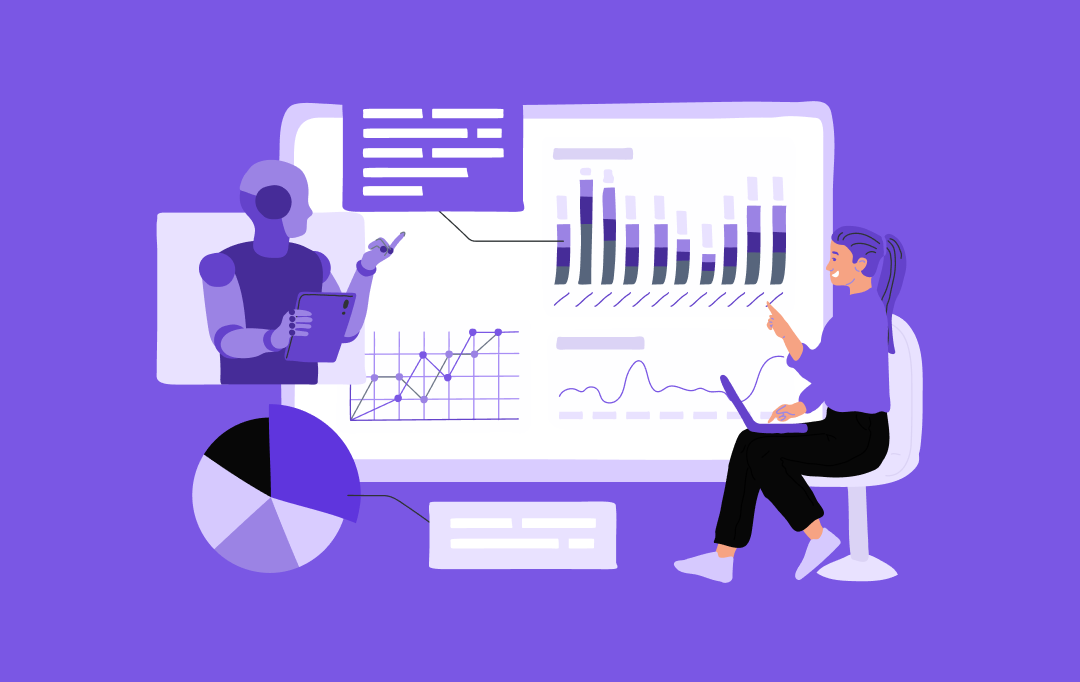
Why Enterprises Need AI Strategy Consulting in Dubai
Key takeaways: Dubai is moving fast with AI adoption. But many enterprises still struggle to move beyond pilots and achieve real business results. AI strategy consulting gives leaders a clear plan. From use-case selection to data readiness, so enterprise AI initiatives stay on track and within budget. AI consulting in Dubai helps enterprises reduce compliance…
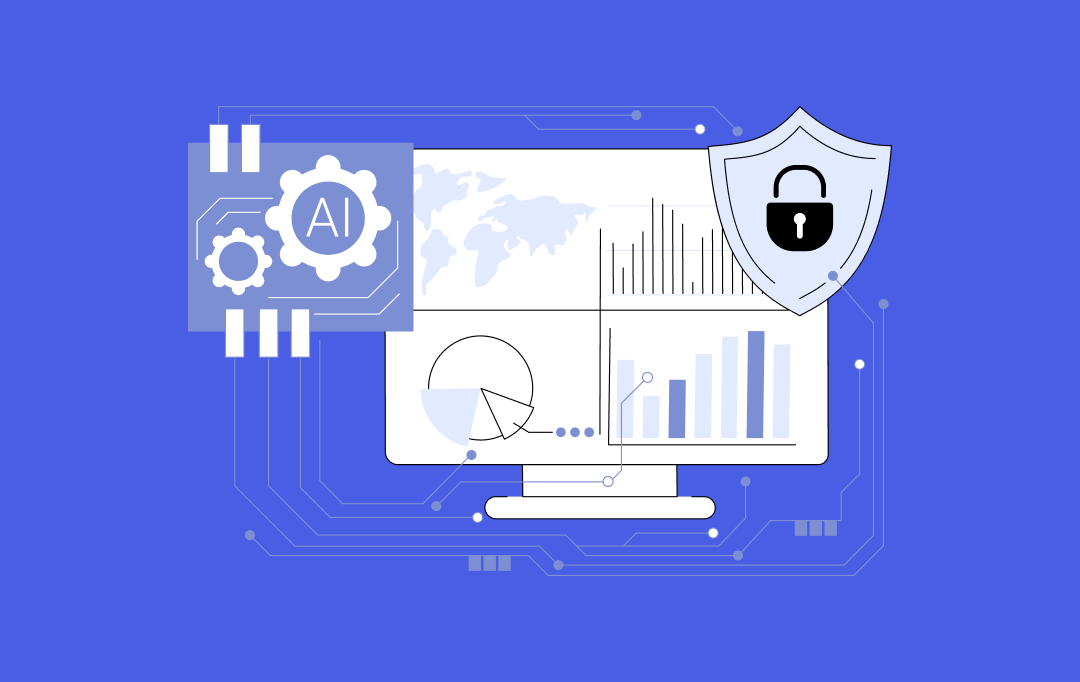
AI Governance Consulting: How to Build Guardrails, Observability, and Responsible AI Pipelines
Key takeaways: Enterprises can no longer rely on principles alone; AI governance must be built into pipelines, model workflows, and decision systems from day one. Strong guardrails across training, inference, retrieval, and agentic actions reduce risks like hallucinations, data leakage, and prompt injection. AI observability is central to governance, giving leaders real-time visibility into drift,…
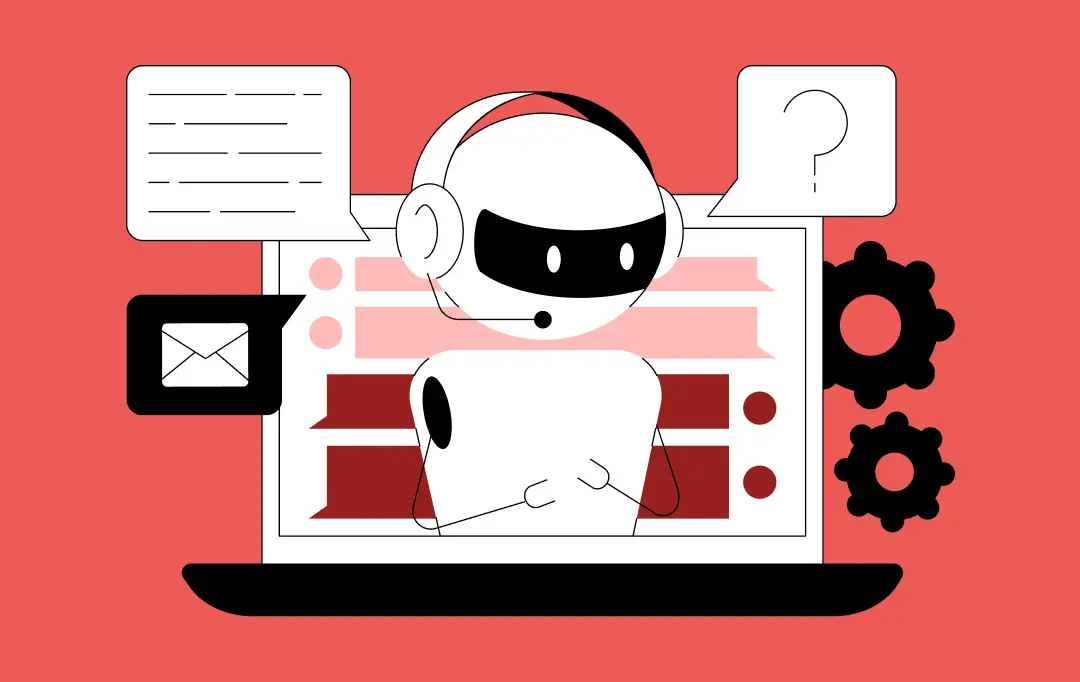
How to Build a Custom Multilingual Chatbot? Features, Process, Costs
Key takeaways: Multilingual Chatbots Drive Revenue Growth: Companies see higher conversion rates when customers can interact in their native language, with nearly 75% of global customers preferring to buy from websites in their preferred language. Beyond Translation to Cultural Intelligence: Successful implementations require cultural adaptation, not just language translation. Systems must understand context, emotion, and…











